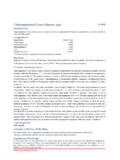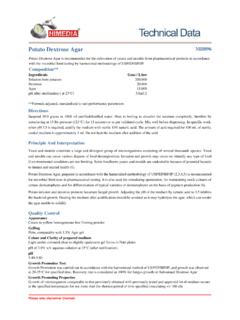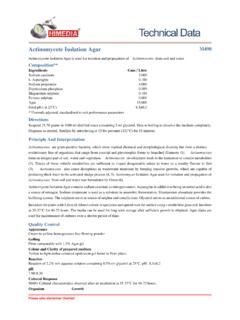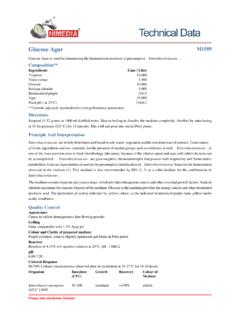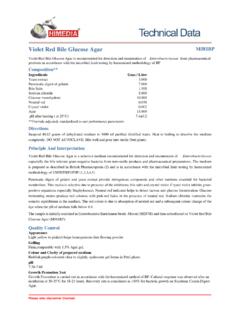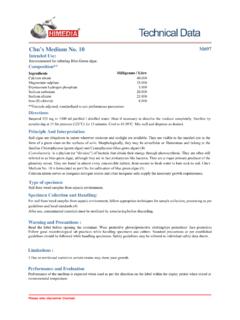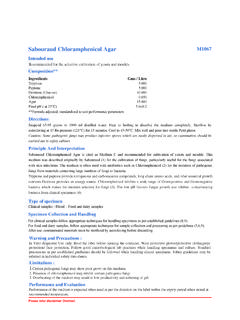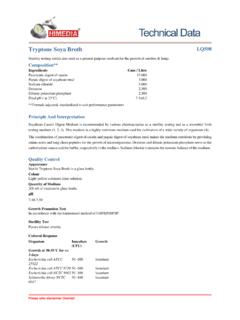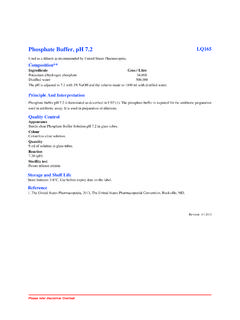Transcription of Yeast Malt Agar (YM Agar) (ISP Medium No. 2)
1 Please refer disclaimer malt agar (YM agar ) (ISP Medium No. 2)Intended useM424 Yeast malt agar (YM agar ) is used for the isolation and cultivation of yeasts, moulds and other aciduric **IngredientsGms / pH ( at 25 C) **Formula adjusted, standardized to suit performance parametersDirectionsSuspend grams in 490 ml distilled water. Heat to boiling to dissolve the Medium completely. Sterilize by autoclaving at15 lbs pressure (121 C) for 15 minutes. For preparing selective media acidify the media up to pH to by asepticallyadding 1 vial of 10% Lactic Acid Solution (FD095). DO NOT HEAT the media after addition of acid. Mix well and pourinto sterile Petri And InterpretationYeast malt agar is formulated as per Wickerham (1, 2) for isolation and cultivation of yeasts, moulds and other aciduric microorganisms.
2 Fungistatic materials such as sodium propionate and diphenyl are added to YM agar to eliminate moulds and thus permits enumeration of yeasts from mixed population. YM agar is also recommended by APHA (3).Wickerham suggested the use of Yeast malt Broth (M425) as an enrichment Medium for yeasts by adding a layer of sterile paraffin oil (about 1 cm) on the surface of inoculated broth. After the growth occurs it should be streaked on YM agar to obtain isolated colonies of fermentative species. To isolate fermentative as well as oxidative strains, acidified YM Broth (M425) is placed on a rotary shaker for 1 or 2 days which favors development of Yeast cells while the sporulation of moulds is prevented and yeasts can be isolated by streaking on YM serves as a source of carbon, nitrogen, long chain amino acids and other essential nutrients.
3 Yeast extract supplies vitamin B complex nutrients and other growth factors. malt extract serves as an additional source of carbon. Dextrose is the carbohydrate and energy source. To increase the selectivity, the media can be acidified by the addition of sterile10% Lactic Acid or by addition of 10% HCl, tartaric acid or 10% citric acid. Alternatively antibiotics (penicillin 20U/ml or streptomycin to a final concentration of 40mcg/ml) can be added. Acidified agar Medium should not be of specimen Clinical samples - Blood ; Food and dairy samples Specimen Collection and Handling: For clinical samples follow appropriate techniques for handling specimens as per established guidelines (4,5).
4 For food and dairy samples, follow appropriate techniques for sample collection and processing as per guidelines (3). Warning and Precautions :In Vitro diagnostic Use only. Read the label before opening the container. Wear protective gloves/protective clothing/eye protection/ face protection. Follow good microbiological lab practices while handling specimens and culture. Standard precautions as per established guidelines should be followed while handling clinical specimens. Safety guidelines may be referred in individual safety data LaboratoriesTechnical DataCultural ResponseM424: Cultural characteristics observed after an incubation at 25-30 C for 40-72 at at (CFU)Cultural ResponseAspergillus brasiliensisgood-luxuriantgood-luxuriant ATCC Candida albicans ATCC good-luxuriant>=50% Escherichia coli ATCC inhibitedgood-luxuriant>=50%50-100 Lactobacillus casei ATCC poorgood-luxuriant>=50%50-100poorgood-lu xuriant>=50%50-1009595 Lactobacillus leichmannii ATCC 4797 Saccharomyces cerevisiae #6%% good-luxuriantgood-luxuriant>=50%50-100 Reference1.
5 Wickerham L. J., 1951, Dept. Agric. Tech. Bull. Wickerham L. J., 1939, J. Tropical Med. Hyg., 42 >=50%50-10050-100 Quality ControlAppearanceCream to beige homogeneous free flowing powderGellingFirm, comparable with agar and Clarity of prepared mediumLight amber coloured clear to slightly opalescent gel forms in Petri of w/v aqueous solution at 25 C. pH : expiry period when stored at Performance and EvaluationPerformance of the Medium is expected when used as per the direction on the label within therecommended :Further biochemical tests must be carried out for confirmation.* Corresponding WDCM numbersPlease refer disclaimer and Shelf LifeStore between 10-30 C in a tightly closed container and the prepared Medium at 20-30 C.
6 Use before expiry date on the label. On opening, product should be properly stored dry, after tightly capping the bottle inorder to prevent lump formation due to the hygroscopic nature of the product. Improper storage of the product may lead to lump formation. Store in dry ventilated area protected from extremes of temperature and sources of ignition Seal the container tightly after use. Use before expiry date on the performance is best if used within stated expiry period. User must ensure safe disposal by autoclaving and/or incineration of used or unusable preparations of this product. Follow established laboratory procedures in disposing of infectious materials and material that comes into contact with clinical sample must be decontaminated and disposed of in accordance with current laboratory techniques (4,5).
7 Y., and Tortorello Fifth (Ed.), 2015, Compendium of Methods for the Microbiological Examination ofFoods, 5th Ed., American Public Health Association, Washington, , Clinical Microbiology Procedures Handbook. 2nd LaboratoriesTechnical , , Pfaller , , Carroll, , Funke, G., Landry, , Richter, and Warnock., (2015)Manual of Clinical Microbiology, 11th Edition. Vol. : 03 / 2019In vitro diagnostic medical device CE MarkingDo not use if package is damagedCE Partner 4U ,Esdoornlaan 13, 3951 DB Maarn The Netherlands, IVDS torage temperature10 C30 CEC REPHiMedia Laboratories Pvt. Limited, 23 Vadhani Industrial Estate, LBS Marg,Mumbai-86,MS,India Disclaimer :User must ensure suitability of the product(s) in their application prior to use.
8 Products conform solely to the information contained inthis and other related HiMedia publications. The information contained in this publication is based on our research and developmentwork and is to the best of our knowledge true and accurate. HiMedia Laboratories Pvt Ltd reserves the right to make changes tospecifications and information related to the products at any time. Products are not intended for human or animal or therapeutic use butfor laboratory,diagnostic, research or further manufacturing use only, unless otherwise specified. Statements contained herein should notbe considered as a warranty of any kind, expressed or implied, and no liability is accepted for infringement of any Laboratories Pvt.
9 Ltd. : 23, Vadhani , LBS Marg, Mumbai-400086, India. Customer care No.: 022-6116 9797 Corporate office : A-516,Swastik Disha Business Park,Via Vadhani Ind. Est., LBS Marg, Mumbai-400086, India. Customer care No.: 022-6147 1919 Email: Website.
